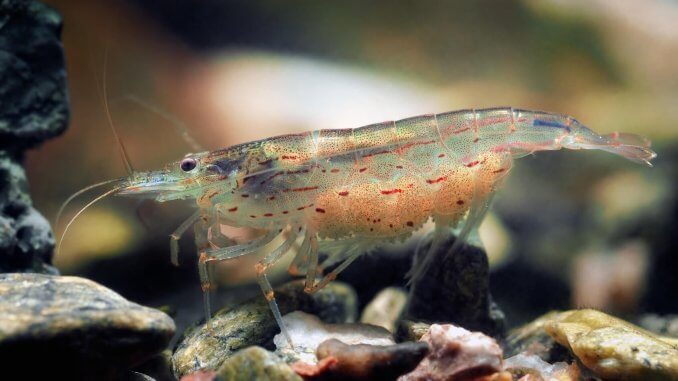
There are more than 600 types of freshwater shrimp available today. Most freshwater shrimp are from the Atyidae family, and some are from the Palaemonoidea superfamily.
Freshwater shrimp are naturally found in slow-flowing streams, springs, and ponds, and appear in colors including red, green, blue, black, and purple.
Shrimp from freshwater environments are usually peaceful, and have useful tank-cleaning abilities, as they eat leftover food and algae on the bottom and the sides of the tank.
This guide will explore the 20 most popular types of freshwater shrimp.
TABLE OF CONTENTS
Common Shrimp Species
These shrimp species are commonly kept in aquarium tanks, and are more widely available at aquarium stores and aquatic pet shops.
Ghost Shrimp
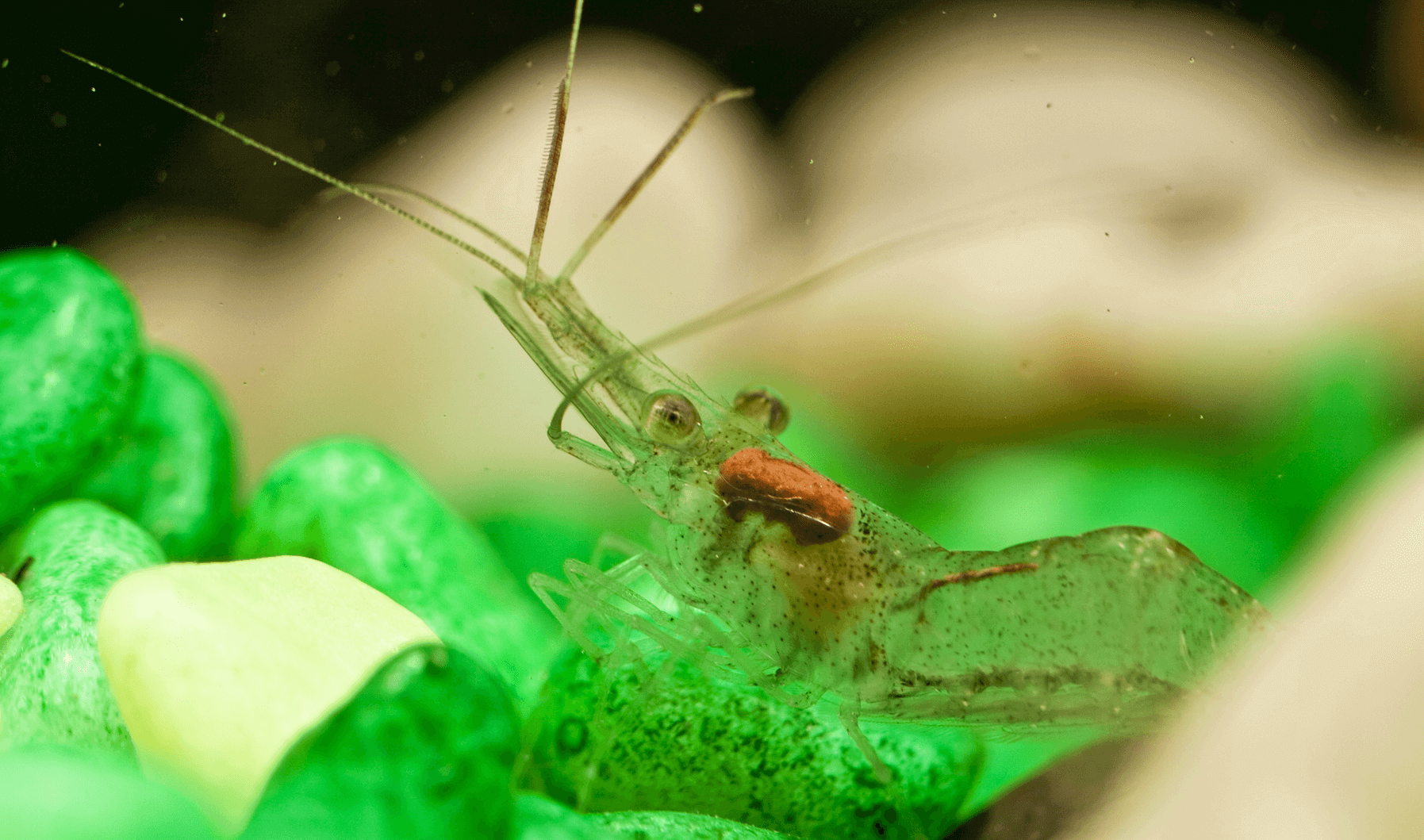
| Care level: | Temperament: | Color: | Lifespan: | Size: |
| Easy | Peaceful | Clear | 1 year | 1.5 inches |
| Water temperature: | Water pH: | Tank size: | Diet: | Scientific name: |
| 65–82°F | 7.0–8.0 | 5–10 gallons | Omnivore | Palaemonetes paludosus |
The ghost shrimp is a small, clear-colored shrimp that grows to 1.5 inches in length. Ghost shrimp are found in slightly brackish freshwater rivers, ponds, and lakes in North America.
With their hardiness, laid-back personalities, and tank-cleaning abilities, ghost shrimp are some of the most popular community aquarium shrimp. Ghost shrimp are nocturnal, preferring to hide during the day.
Ghost shrimp can be housed with peaceful, small fish, and peaceful bottom dwellers, like kuhli loaches, cory catfish, and freshwater snails. Don’t house ghost shrimp with large fish that are known to eat shrimp.
A water temperature of 65–82°F and a slightly alkaline pH are ideal for ghost shrimp.
Whisker Shrimp
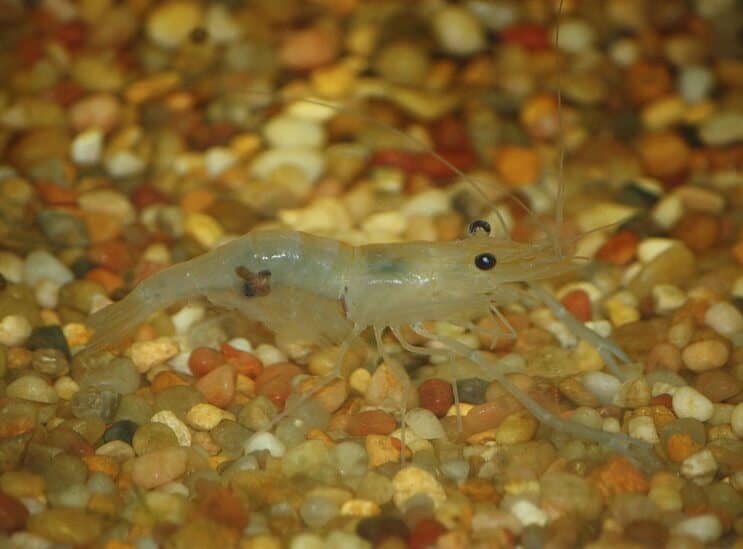
| Care level: | Temperament: | Color: | Lifespan: | Size: |
| Easy | Semi-aggressive | Semi-transparent, gray | 1–2 years | 1–2 inches |
| Water temperature: | Water pH: | Tank size: | Diet: | Scientific name: |
| 72–82°F | 7.0–7.8 | 10 gallons | Omnivore | Macrobrachium lanchesteri |
Whisker shrimp, or Indian whisker shrimp, have transparent bodies and look similar to ghost shrimp. You can tell a ghost shrimp and a whisker shrimp apart by their feelers — the whisker shrimp has longer feelers than the ghost shrimp.
Whisker shrimp inhabit slightly brackish freshwater bodies in Nepal. Due to their widespread availability, whisker shrimp are cheap to buy, making them a popular aquarium shrimp.
Because whisker shrimp are known to be aggressive towards other shrimp species and fish, the shrimp should be housed with top- or middle-dwelling fish, like hatchetfish, mollies, and platies, that stay out of the whisker shrimp’s way.
Whisker shrimp prefer a water temperature of 72–82°F, with a neutral pH between 6.5 and 7.5.
Vampire Shrimp
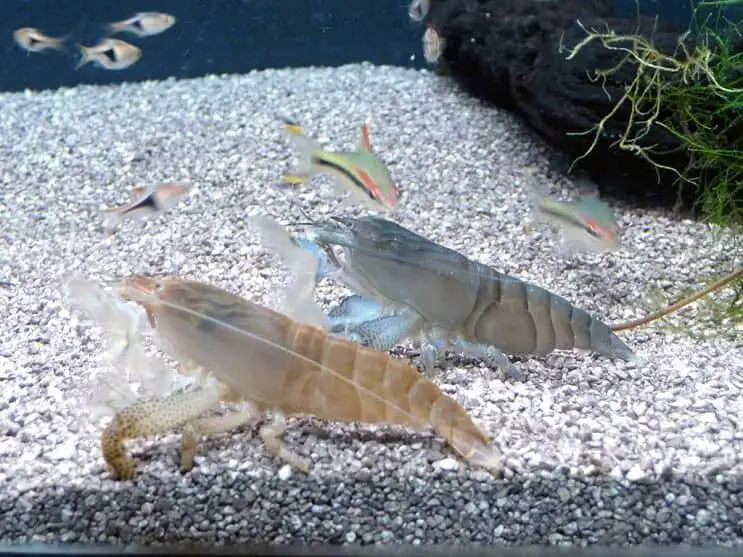
| Care level: | Temperament: | Color: | Lifespan: | Size: |
| Easy–moderate | Peaceful | Varied, color-changing | 5 years | 2–3 inches |
| Water temperature: | Water pH: | Tank size: | Diet: | Scientific name: |
| 75–84°F | 6.5–7.5 | 15 gallons | Omnivore | Atya gabonensis |
The vampire shrimp appears in a range of colors, including pink, green, gray, blue, and brown. The name “vampire shrimp” describes the spikes in the shrimp’s feet, which look like fangs.
Vampire shrimp are a calm, peaceful shrimp species that have fascinating feeding habits — they’re filter feeders, meaning they filter microorganisms from the water.
Vampire shrimp are compatible with other shrimp species, as well as snails, and non-aggressive fish species like guppies, mollies, danios, and cherry barbs. Don’t house vampire shrimp with cichlids, goldfish, and any semi-aggressive fish species that could eat the shrimp.
A water temperature of 75–84°F and a mildly acidic-to-neutral pH are ideal for vampire shrimp.
Bamboo (Flower) Shrimp
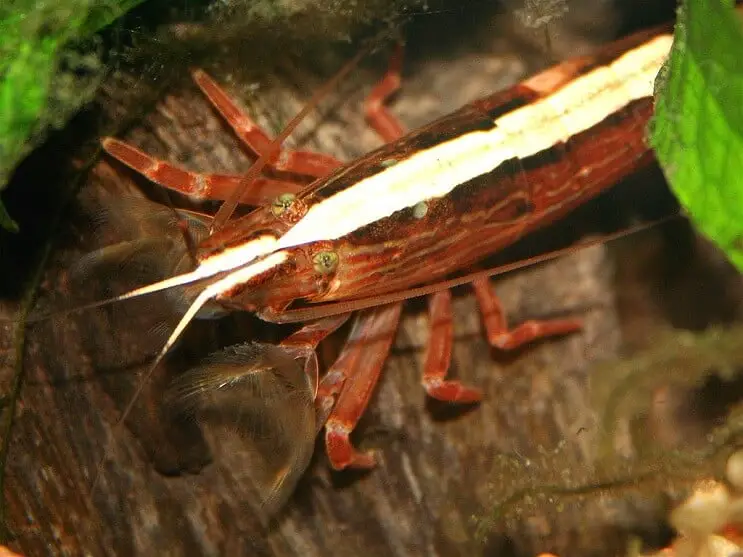
| Care level: | Temperament: | Color: | Lifespan: | Size: |
| Easy | Peaceful | Reddish-brown | 2 years | 2–3 inches |
| Water temperature: | Water pH: | Tank size: | Diet: | Scientific name: |
| 75–77°F | 6.0–6.8 | 10 gallons | Omnivore | Atyopsis moluccensis |
The bamboo shrimp, otherwise known as the Singapore flower shrimp or the wood shrimp, is a pale, reddish-brown shrimp that is bigger than most of the freshwater aquarium shrimp on this list.
Bamboo shrimp are found in southeast Asia, including Thailand, the Philippines, and Sri Lanka. Bamboo shrimp are gentle and less skittish than other shrimp species.
Ideal tank mates for the bamboo shrimp are zebra and pearl danios, pearl gouramis, cory catfish, and kuhli loaches, along with other shrimp species, like vampire and cherry shrimp.
Bamboo shrimp enjoy fast-flowing water with a temperature of 75–77°F and a slightly acidic pH.
Amano Shrimp
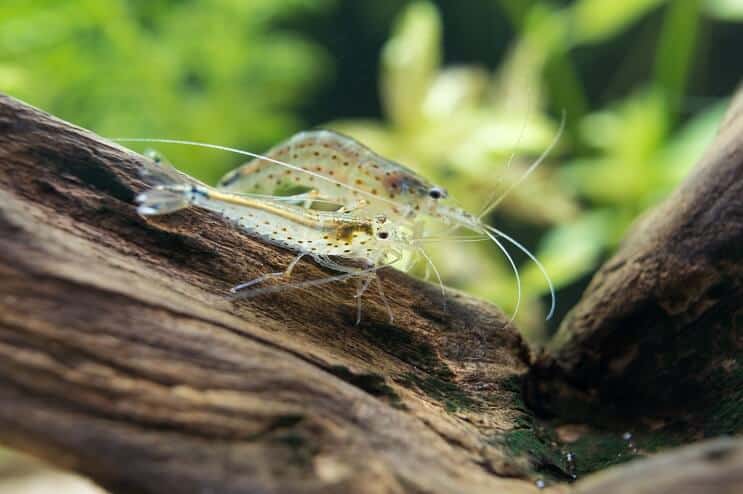
| Care level: | Temperament: | Color: | Lifespan: | Size: |
| Easy | Peaceful | Gray/transparent | 2–3 years | 2 inches |
| Water temperature: | Water pH: | Tank size: | Diet: | Scientific name: |
| 70–80°F | 6.0–7.0 | 10 gallons | Omnivore | Caridina multidentata |
The Amano shrimp is a translucent, light-gray shrimp with shades of green, red, and light brown. Amano shrimp are native to Japan, Taiwan, and China, and live in large troupes in freshwater streams and rivers.
Amano shrimp are born in the ocean and swim into brackish rivers when they undergo metamorphosis. The Amano shrimp is hard to breed, but popular due to its reputation for controlling algae in freshwater tanks.
Amano shrimp are peaceful shrimp that can be housed with other peaceful fish and invertebrates, including guppies, small tetras, betta fish, peaceful barbs, vampire shrimp, and mystery snails.
Warm water between 70–80°F and a slightly acidic-to-neutral pH is ideal for an Amano shrimp tank.
Cherry Shrimp
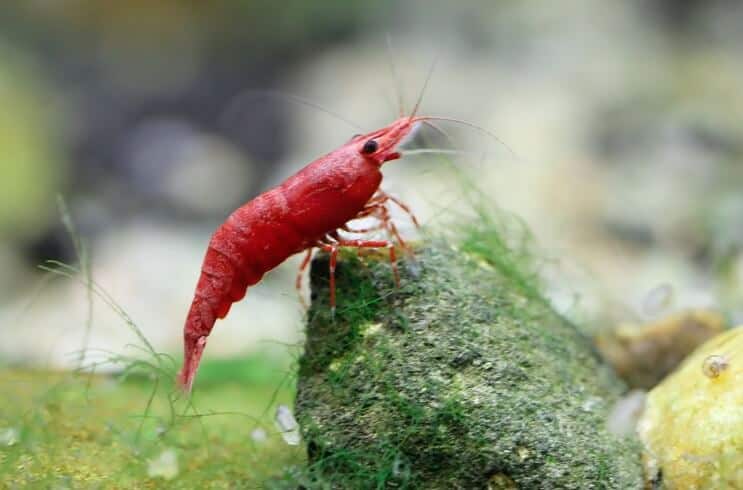
| Care level: | Temperament: | Color: | Lifespan: | Size: |
| Easy | Peaceful | Red | 1–2 years | 1.5 inches |
| Water temperature: | Water pH: | Tank size: | Diet: | Scientific name: |
| 65–85°F | 6.5–8.0 | 5 gallons | Omnivore | Neocaridina davidi |
The cherry shrimp is a clear-colored dwarf shrimp with cherry-red patches. Cherry shrimp live in streams and ponds with densely-packed plants and rocky substrates in South-East Asia.
These bright red shrimp are popular amongst aquarists due to their inexpensive care needs and ability to survive in a range of water parameters.
Cherry shrimp are peaceful and shy, and should be housed with small, peaceful tank mates that won’t bully or attempt to eat the shrimp. Freshwater snails, neon tetras, Amano and ghost shrimp, dwarf gouramis, and bristlenose plecos are good tank mates for cherry shrimp.
Cherry shrimp thrive in a water temperature of 65–85°F and a pH between 6.5 and 8.
Blue Bolt Shrimp
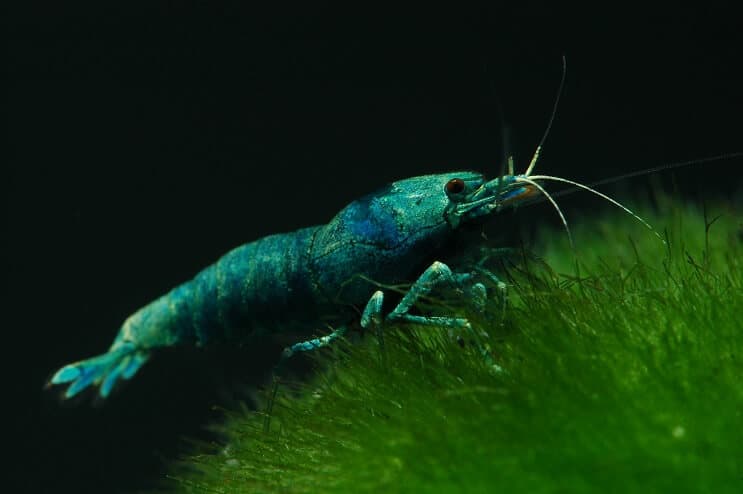
| Care level: | Temperament: | Color: | Lifespan: | Size: |
| Easy | Peaceful | Bright blue | 1.5–2 years | 1–1.5 inches |
| Water temperature: | Water pH: | Tank size: | Diet: | Scientific name: |
| 68–78°F | 6.0–6.8 | 10 gallons | Omnivore | Caridina cf cantonensis |
Blue bolt shrimp are vivid dwarf shrimp that are popular due to their brilliant blue coloration, ranging from shades of aquamarine to royal blue.
In the wild, blue bolt shrimp are abundantly found in aerated mountain creeks and streams in southern China. The blue bolt shrimp is a peaceful shrimp and an effective tank cleaner.
Compatible tank mates for blue bolt shrimp are other shrimp, like bamboo and tiger shrimp, as well as freshwater snails and peaceful fish like neon tetras. Blue bolt shrimp prefer to be housed in groups of at least six. Avoid housing blue bolt shrimp with large or aggressive fish species.
Ensure water temperatures remain within 68–78°F, with a slightly acidic pH between 6.0 and 7.5, for the shrimp to thrive.
Tiger Shrimp
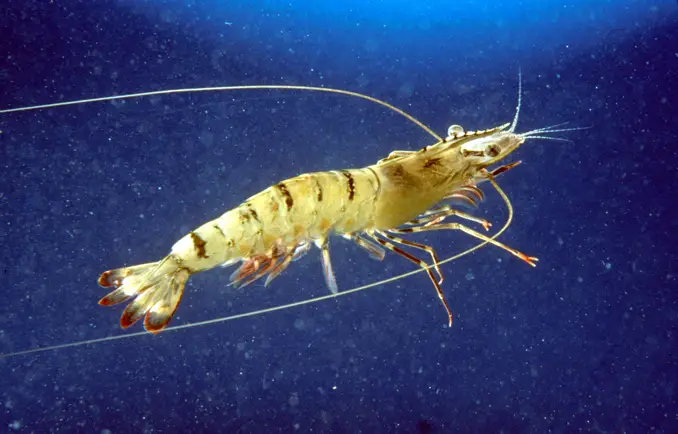
| Care level: | Temperament: | Color: | Lifespan: | Size: |
| Easy | Peaceful | Gray-blue with dark stripes | 3 years | 1–1.25 inches |
| Water temperature: | Water pH: | Tank size: | Diet: | Scientific name: |
| 76–78°F | 6.0–7.5 | 10 gallons | Omnivore | Caridina cf cantonensis |
The tiger shrimp is a gray-blue shrimp with black stripes. The tiger shrimp is named for its orange appearance when cooked (tiger shrimp are popular in Japanese cuisine).
Amongst fishkeeping enthusiasts, tiger shrimp are popular due to their ease of care and breeding, and their relaxed personalities.
Tiger shrimp are compatible with other shrimp species, like cherry shrimp, as well as small fish species, like danios and plecos, and freshwater snails.
Tiger shrimp prefer slow-flowing, oxygenated, slightly acidic-to-neutral water with a temperature range between 76–78°F. The tiger shrimp is a shy species, and the shrimp is most active when the aquarium is dark.
Pinocchio (Red Nose) Shrimp
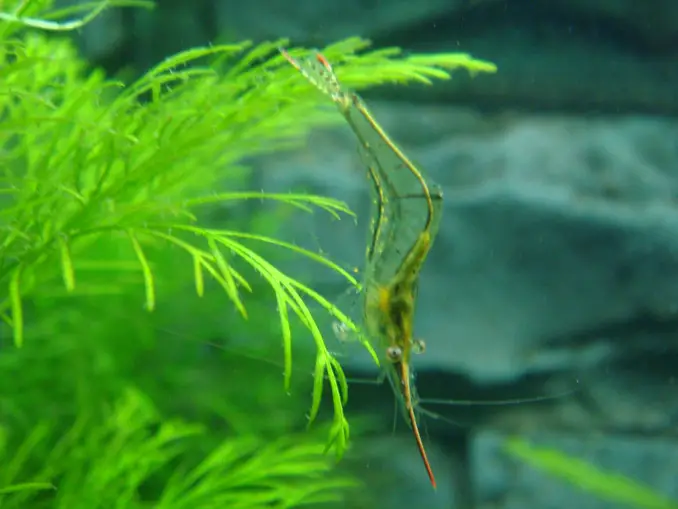
| Care level: | Temperament: | Color: | Lifespan: | Size: |
| Easy | Peaceful | Semi-transparent with a yellow and red stripe | 1.5–2 years | 1.5 inches |
| Water temperature: | Water pH: | Tank size: | Diet: | Scientific name: |
| 75–80°F | 7.0–8.0 | 10 gallons | Omnivore | Caridina gracilirostris |
The Pinocchio shrimp, otherwise known as the red nose shrimp, is a translucent-colored shrimp with a red and yellow stripe along its body and a distinctive red nose.
Pinocchio shrimp live in brackish lakes and slow-moving streams in Japan, Madagascar, Fiji, Malaysia, Singapore, Thailand, and China. These peaceful shrimp have a unique appearance that appeals to many aquarists, but they’re not as commonly available as other shrimp species.
Pinocchio shrimp are compatible with other shrimp, like tiger shrimp, ghost shrimp, Amano shrimp, blue bolt shrimp, and vampire shrimp. Other good tank mates for Pinocchio shrimp are freshwater snails and small, peaceful fish, like pygmy cory catfish.
A water temperature of 75–80°F and a pH of 7.0–8.0 is ideal for a Pinocchio shrimp tank.
Bee Shrimp
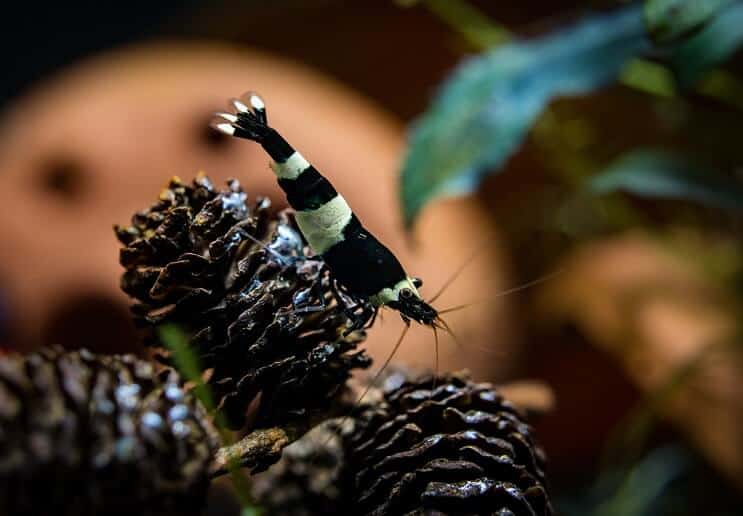
| Care level: | Temperament: | Color: | Lifespan: | Size: |
| Easy | Peaceful | Pale with black, yellow, or red stripes | 1–2 years | 1 inch |
| Water temperature: | Water pH: | Tank size: | Diet: | Scientific name: |
| 68–78°F | 5.8–6.8 | 5 gallons | Omnivore | Caridina cantonensis |
The bee shrimp is one of the most popular and widely available types of freshwater shrimp. Bee shrimp are small, growing to just 1 inch long.
The bold bands of black, yellow, or red on the bee shrimp’s body give the shrimp a bumblebee-like appearance. Bee shrimp are beautiful and easy to care for, with bolder personalities than most other shrimp species.
Good tank mates for bee shrimp are other shrimp species, like crystal shrimp and blue bolt shrimp, and freshwater snails, like ramshorn snails and nerite snails. Neon tetras are good fish species to house with bee shrimp.
Ensure the tank’s water temperature is within 68–78°F and the pH is slightly acidic — between 5.8 and 6.8.
Green Lace Shrimp
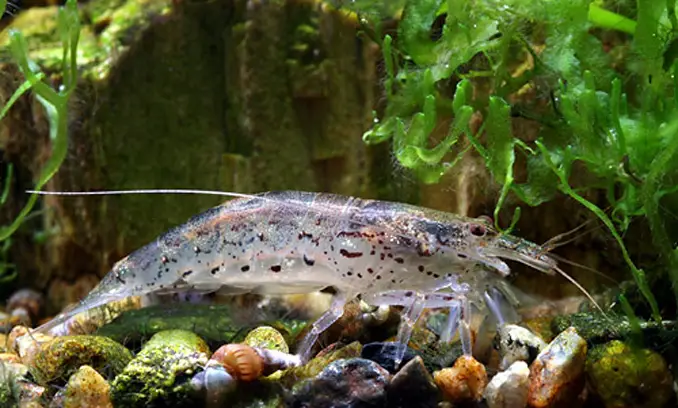
| Care level: | Temperament: | Color: | Lifespan: | Size: |
| Moderate | Peaceful | Pale yellow or green, with faint horizontal stripes | 1.5–2 years | 1.5–3 inches |
| Water temperature: | Water pH: | Tank size: | Diet: | Scientific name: |
| 70–78°F | 6.5–7.5 | 20 gallons | Omnivore | Atyopsis pilipes |
The green lace shrimp is a close relative to the bamboo shrimp, and has a pale yellow, brown, or green body with faint brown horizontal stripes.
Green lace shrimp are found in Southeast Asia, and aren’t as widely available in the fish trade compared to other shrimp species. These shrimp are popular with shrimp enthusiasts due to their unique filter-feeding habits and variable coloration.
Green lace shrimp can be housed singularly or in a group with other green lace shrimp and other shrimp species. The shrimp are compatible with white cloud mountain minnows, bamboo shrimp, cherry shrimp, and freshwater snails.
Ideal tank conditions for green lace shrimp are warm waters between 70 and 78°F and an acidic-to-neutral pH of 6.5–7.5.
Cardinal Shrimp
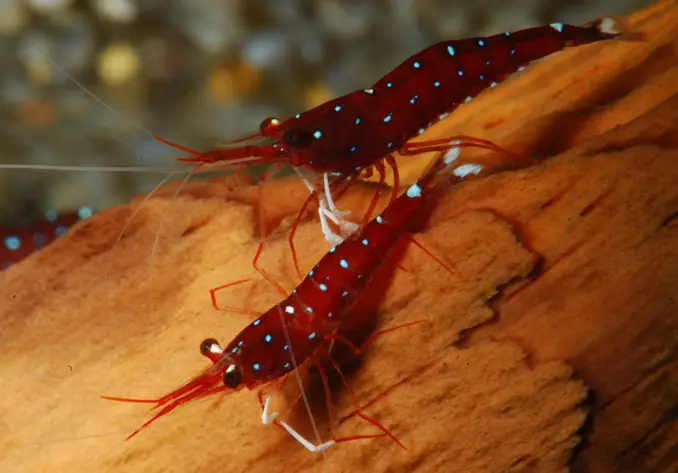
| Care level: | Temperament: | Color: | Lifespan: | Size: |
| Moderate | Peaceful | Red with white spots | 2 years | 0.5–1 inches |
| Water temperature: | Water pH: | Tank size: | Diet: | Scientific name: |
| 78–88°F | 7.8–8.2 | 10 gallons | Omnivore | Caridina dennerli |
Cardinal shrimp are small, vibrant dwarf shrimp with bold red bodies patterned with white spots. The cardinal shrimp was discovered in 2007 in the Sulawesi region of Indonesia, and is one of the newest shrimp species in the aquarium trade.
Despite the cardinal shrimp’s tiny size — some cardinal shrimp don’t even reach 1 inch long — the shrimp is popular due to its attractive appearance and tank-cleaning behavior.
Cardinal shrimp are small, colorful, and shy, making them easy prey for bullies. Don’t house cardinal shrimp with large, aggressive fish. Good tank mates for cardinal shrimp are Sulawesi snails, which originate from the same region as the shrimp, and other shrimp from the Sulawesi region, like Malawa shrimp.
Cardinal shrimp thrive in water temperatures between 78 and 88°F, with a slightly alkaline pH.
Neocaridina Shrimp
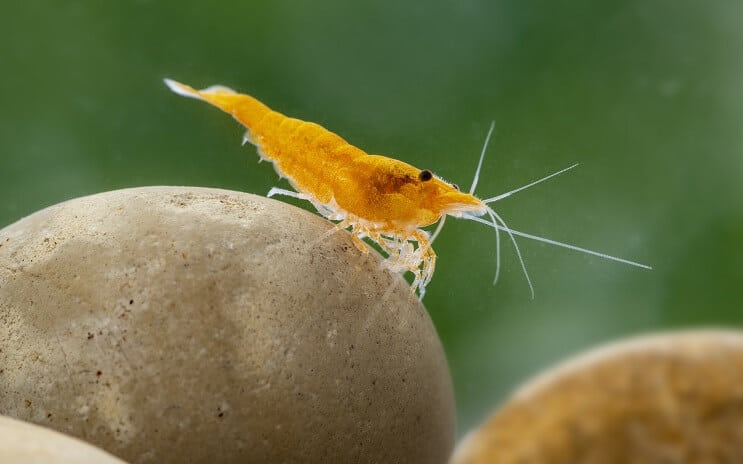
| Care level: | Temperament: | Color: | Lifespan: | Size: |
| Moderate | Peaceful | Yellow or translucent | 1–1.5 years | 1.5–2 inches |
| Water temperature: | Water pH: | Tank size: | Diet: | Scientific name: |
| 62–84°F | 6.8–7.5 | 10 gallons | Omnivore | Neocaridina davidi |
The neocaridina shrimp, or the yellow shrimp, is a sibling of the red cherry shrimp. The natural habitat of the neocaridina shrimp is freshwater streams in Southeast Asia, including China, Japan, and Taiwan.
Neocaridina shrimp have lemon-yellow bodies and are a beginner-friendly species, with peaceful personalities and low care needs.
Good tank mates for the neocaridina shrimp are dwarf gouramis, neon tetras, male betta fish, bristlenose plecos, small rasboras, and cory catfish. Other shrimp species and freshwater snails are also compatible with neocaridina shrimp.
Ideal water conditions for a neocaridina shrimp tank are a temperature range of 62–84°F and a pH range of 6.8–7.5.
Shrimp Hybrids
These shrimp hybrids aren’t as common as individual species of freshwater shrimp, but their unique appearance makes them an attractive addition to the home aquarium.
Crystal Red (Bee) Shrimp
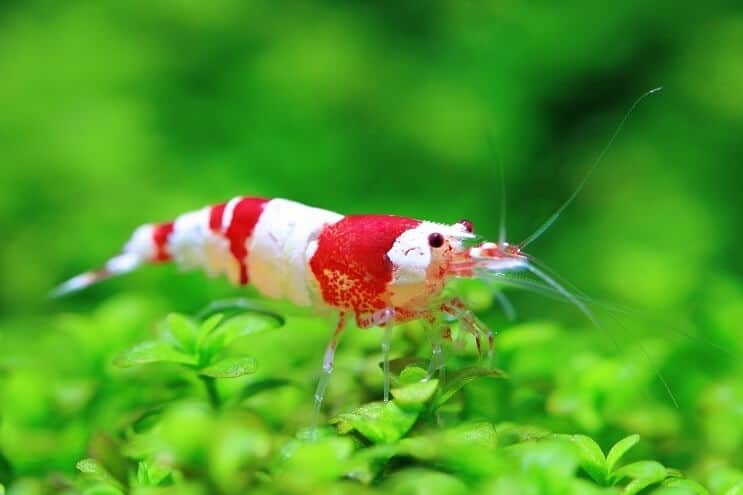
| Care level: | Temperament: | Color: | Lifespan: | Size: |
| Intermediate | Peaceful | Red and white | 1.5–2 years | 1.2 inches |
| Water temperature: | Water pH: | Tank size: | Diet: | Scientific name: |
| 71–77°F | 5.8–7.4 | 10 gallons | Omnivore | Caridina cantonensis |
The crystal red shrimp is a red and white dwarf shrimp, growing to just 1.2 inches long. Crystal red shrimp are color variants of the bee shrimp and only exist through selective breeding of this shrimp species.
Crystal red shrimp are some of the most attractive shrimp for home aquariums, and are known for their laid-back personalities.
The crystal red shrimp’s small size makes it vulnerable to predation, so you should house the shrimp with small, peaceful fish species that won’t try to eat the shrimp. Neon tetras, zebra danios, cherry barbs, and guppies are all good tank mates for crystal red shrimp.
Ideal water conditions for this shrimp species are a temperature of 71–77°F and a slightly acidic pH of 5.2–6.8.
Tibee (Tiger Bee) Shrimp
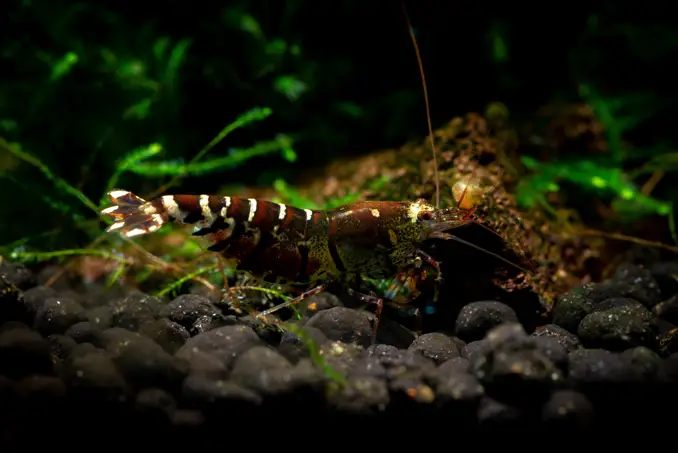
| Care level: | Temperament: | Color: | Lifespan: | Size: |
| Intermediate | Peaceful | Black or clear with red and yellow stripes | 1–2 years | 0.8–1.2 inches |
| Water temperature: | Water pH: | Tank size: | Diet: | Scientific name: |
| 62–76°F | 5.2–6.8 | 10 gallons | Omnivore | Caridina cantonensis |
The tibee shrimp, or tiger bee shrimp, is a hybrid between a tiger shrimp and a crystal red shrimp.
Tibee shrimp have transparent or black bodies with bold red, yellow, and white stripes. The shrimp are bred in captivity for their attractive appearance and aren’t found in the wild.
Ideal tank mates for the tibee shrimp are other shrimp species, like cherry shrimp, and freshwater snails. Because tibee shrimp are shy, the shrimp should be housed with small, top-dwelling fish that won’t compete with the shrimp for food. Tibee shrimp are more adaptable to water parameters than bee shrimp.
Tibee shrimp thrive in water temperatures in the low 60s to the mid-70s, with an acidic pH of 5.2 to 6.8.
Pinto Shrimp
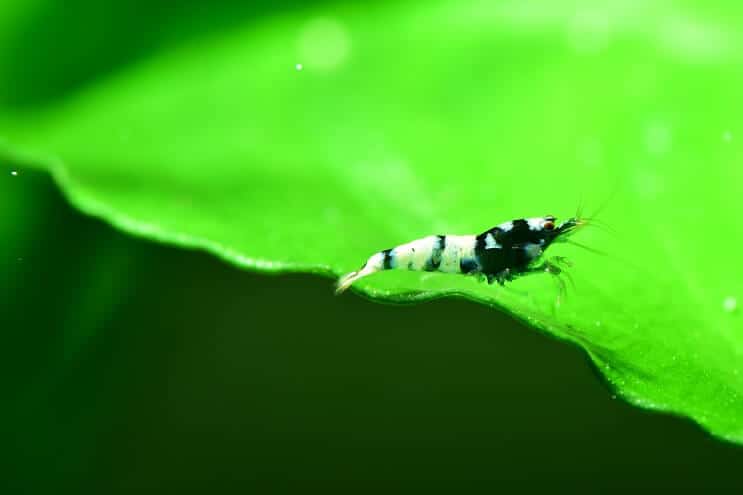
| Care level: | Temperament: | Color: | Lifespan: | Size: |
| Intermediate | Peaceful | Black and white or red and white | 1–2 years | 0.75–1.25 inches |
| Water temperature: | Water pH: | Tank size: | Diet: | Scientific name: |
| 64–76°F | 5.2–6.8 | 5–10 gallons | Omnivore | Caridina cantonensis |
The pinto shrimp is a cross between a tibee shrimp and a Taiwan bee shrimp. Pinto shrimp have three different pattern variations: spotted head, zebra, or skunk pattern, in colors including black, white, and red.
Because pinto shrimp have been bred from other shrimp, they don’t exist naturally in the wild. Pinto shrimp are popular due to their colorful bodies and easygoing temperaments.
Pinto shrimp get along well with other pintos, freshwater snails, other shrimp species, and peaceful fish species like corydoras.
The ideal water temperature range for pinto shrimp is 64–76°F, with a neutral or slightly acidic pH of 6.5–8.0.
Snowball Shrimp
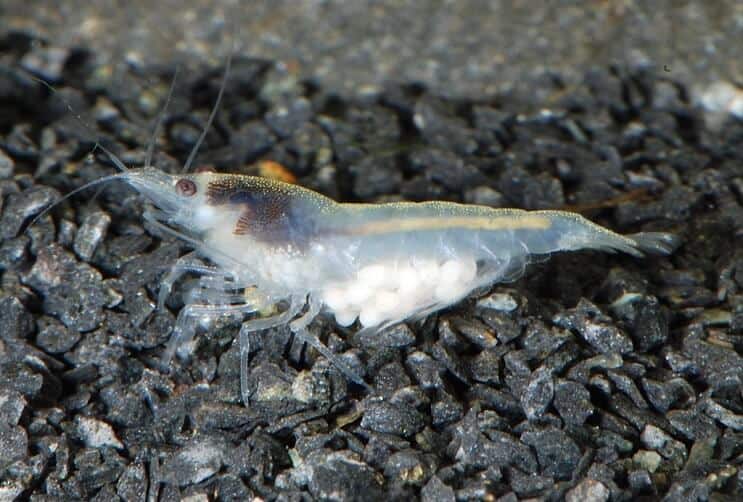
| Care level: | Temperament: | Color: | Lifespan: | Size: |
| Easy | Peaceful | Translucent white | 1–2 years | 1–1.2 inches |
| Water temperature: | Water pH: | Tank size: | Diet: | Scientific name: |
| 65–85°F | 6.5–8.0 | 10 gallons | Omnivore | Neocaridina zhangiajiensis var. |
The snowball shrimp gets its name from its translucent white body, and the white, snowball-like eggs females produce after breeding.
Snowball shrimp, otherwise known as white pearl shrimp, have wild roots in Taiwan but were bred for their white color in Germany. These shrimp are ideal for beginners because they’re tolerant to a range of water conditions, sociable in community tanks, and easy to care for.
Snowball shrimp do well in peaceful community tanks, with snails, harmless fish species like pygmy corydoras and kuhli loaches, and other snowball shrimp.
Ideal tank conditions for snowball shrimp are temperatures between 65–85°F and a pH of 6.5–8.0.
Red Rili Shrimp
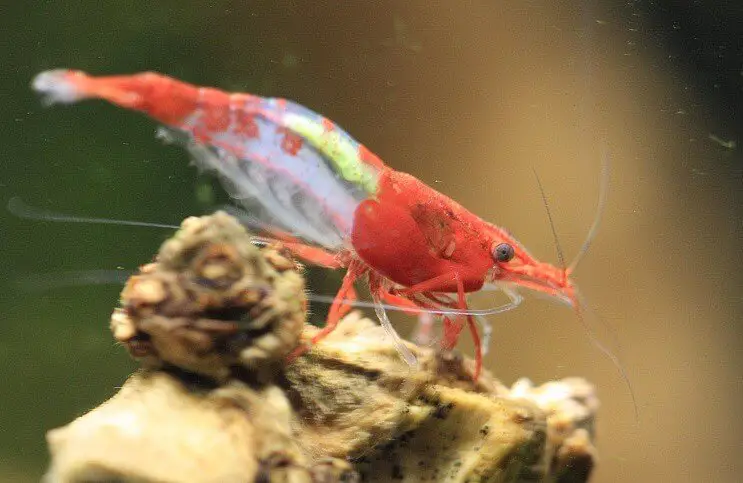
| Care level: | Temperament: | Color: | Lifespan: | Size: |
| Easy | Peaceful | Red with white spots | 2 years | 0.5–1 inch |
| Water temperature: | Water pH: | Tank size: | Diet: | Scientific name: |
| 78–88°F | 7.8–8.2 | 10 gallons | Omnivore | Caridina dennerli |
The red rili shrimp is a red, white, and clear-bodied shrimp that has been selectively bred from the red cherry shrimp, which is native to freshwater streams in Taiwan. Red rili shrimp are a dwarf shrimp variety, growing to 1 inch long. These shrimp are popular due to their bold coloring and their ability to manage waste and control algae growth in a tank.
Red rili shrimp get along well with small, calm bottom-feeding fish, like kuhli loaches. Other dwarf shrimp species, freshwater snails, and micro crabs are also good tank mates for red rili shrimp.
Maintain a water temperature of 78–88°F and a pH of 7.8–8.2 for red rili shrimp to thrive. The red rili shrimp is a shy species that prefers heavily-planted tanks with lots of hiding spaces.
Blue Velvet Shrimp
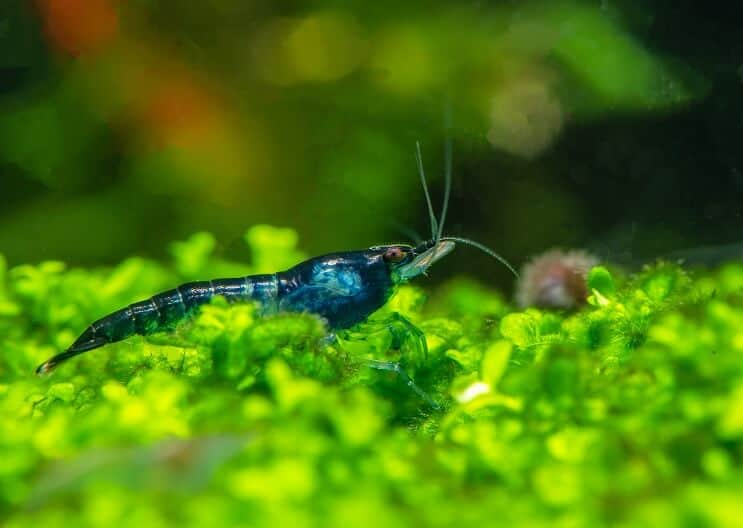
| Care level: | Temperament: | Color: | Lifespan: | Size: |
| Easy | Peaceful | Blue with black spot | 1–2 years | 2 inches |
| Water temperature: | Water pH: | Tank size: | Diet: | Scientific name: |
| 68–80°F | 6.4–8.0 | 5–10 gallons | Omnivore | Neocaridina davidi var. Blue |
The blue velvet shrimp is a striking blue shrimp with a black spot near the head. This vibrant shrimp species is another color morph of the red cherry shrimp, originating in Taiwan.
Blue velvet shrimp are a peaceful species and are often used as tank cleaners due to their habit of eating everything, including algae.
These bright blue shrimp are compatible with other shrimp species, like cherry shrimp, Amano shrimp, and bamboo shrimp. Freshwater snails and peaceful fish, like bristlenose plecos, gouramis, hillstream loaches, and cory catfish are other good tank mates for blue velvet shrimp.
Blue velvet shrimp prefer a water temperature of 68–80°F and a pH of 6.4–8.0.
Blue Pearl Shrimp
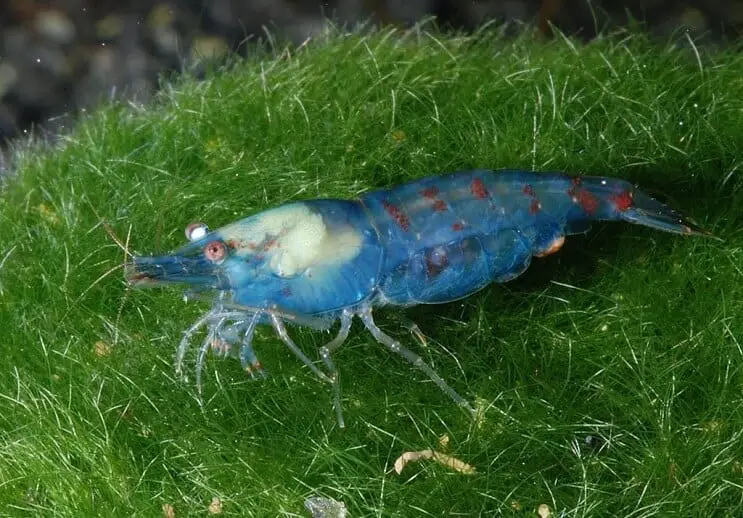
| Care level: | Temperament: | Color: | Lifespan: | Size: |
| Easy | Peaceful | Transparent blue | 1–2 years | 1–2 inches |
| Water temperature: | Water pH: | Tank size: | Diet: | Scientific name: |
| 60–85°F | 6.5–8.0 | 10 gallons | Omnivore | Neocaridina cf. zhangjiajiensis |
The blue pearl shrimp is the blue version of the snowball shrimp. Blue pearl shrimps have transparent blue bodies with white spots on their heads.
The wild habitat of blue pearl shrimp is Taiwan, but the blue variation was first bred in Germany. Blue pearl shrimp stand out with their vibrant blue colors. The shrimp is an active, peaceful species, and is a good choice for a colorful community aquarium.
Like snowball shrimp, blue pearl shrimp can be housed with pygmy corydoras, kuhli loaches, snails, and other shrimp of their kind.
Blue pearl shrimp prefer water temperatures of 60–85°F and a pH of 6.5–8.0.
Choosing & Caring For Different Types of Freshwater Shrimp
Shrimp are a fun addition to a freshwater aquarium, providing entertainment with their fascinating tank-cleaning habits and acting as unique tank mates to a community of fish.
Most shrimp species are hardy and can be kept by beginner and experienced hobbyists. To care for freshwater shrimp, provide a complex habitat, with lots of plants, rocks, driftwood, and caves to mimic the shrimp’s natural habitat. Ensure water flow is mild-to-moderate, maintain good filtration, and change between 10 and 20% of the water every week.
Only buy freshwater shrimp if your tank contains peaceful, small fish, preferably upper-dwelling fish that won’t disturb the shrimp. Keep your color preferences and budget in mind when choosing shrimp for your tank, and make sure to buy freshwater (not saltwater) shrimp. Most shrimp species can be kept together, and some species of the same genus can interbreed.

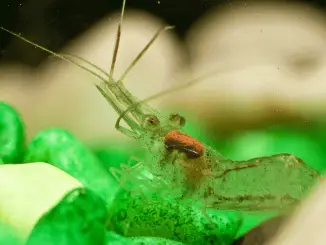
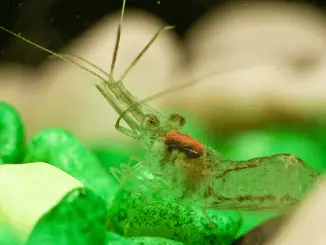
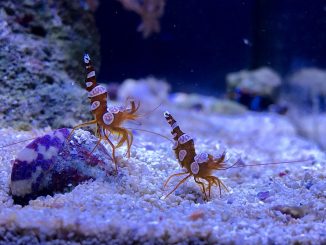
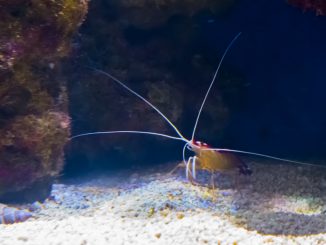
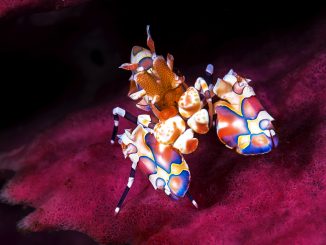

I am interested in putting Blue Velvet shrimp in my fifty five gallon planted aquarium. Where would be the best place to source these from? How many is recommended for this tank size?
I would love to add shrimp to my 29 gallon tank. I have (1) red line shark,4″ (my oldest fish, 7 years), (2)zebra loaches, 2″ (3)yoyo loaches, 1.5″, (1)pleco, 3″ and (6) mollies, 1″ each. Am I at my limit? I use to have a red claw crab, but he would escape. Also, had small angle fish, 2 before the mollies. Is there anything interesting I could add?